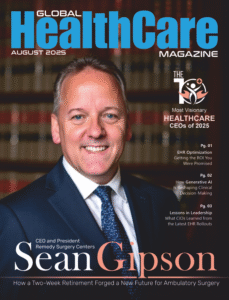The continuously changing healthcare landscape requires leaders to be dynamic as well as proactive. To outsmart the competition, Leaders must be able to handle the present while also calculating the future, comprehending the possibilities, and dealing with legislation. As the healthcare sector is heavily regulated, a healthcare leader faces intense scrutiny today.
Rising above the odds, Kevin Goodwin, the CEO of EchoNous has inculcated the qualities required to be an excellent leader in the healthcare industry. Kevin has been in the global ultrasound business for 34 years and has worked in commercial healthcare for 41 years. He has been a leader, innovator, and student of “point of care ultrasound” (POCUS) for more than 20 years.
Stepping Stones
Kevin decided to pursue a career in healthcare in high school after his mentor told him: “You’ll always have a job because healthcare is a booming business, it’s always going to be needed.” He entered college intending to major in Hospital Management, but after completing a yearlong internship at a nearby hospital, he changed his mind and chose to work in the private sector. Kevin began working for American Hospital Supply right out of college, entering the world of commercial healthcare, private site healthcare, and corporate delivery of goods and services. Four years later, he quit that organization and joined Picture International.
At that time, important tools were accessible, nuclear scanning was expanding, and MRI, CT scanning, and ultrasound were all experiencing renaissance. Kevin got into the ultrasound business in 1987 and worked for a company named ATL. He eventually relocated to Seattle to take the position of Director of Training, and after working closely with the CEO, he has named the head of ultrasound. The first to offer point-of-care ultrasound was formed. POCUS is what Sonosite created and led.
Inauguration of EchoNous
After selling Sonosite in 2012, Kevin founded EchoNous a few years later. EchoNous has proved over time to become the market leader in the miniaturization of high-quality ultrasound. The purpose of EchoNous is to use computer vision, machine learning, and deep learning to improve the use of ultrasound technology in healthcare. The company strives to use a highly innovative hardware platform that can be carried by hand and has the performance and functionality of a much bigger, more expensive device.
EchoNous has taken the leadership position of applying deep learning, machine learning, and computer vision to how all ultrasound devices are used from front to back. For teacher-student communication, the company has software that automates quality assurance and coaching. The paradigm of what can be done with hand-carried ultrasound equipment has
been completely dismantled by EchoNous’ Kosmos hardware. It images incredibly well, and more doctors are learning this each passing day. With its many layers of AI, EchoNous focuses on image acquisition, which is the most difficult aspect of ultrasound due to user dependence, image interpretation, logical calculations, and decision-making at the end.
Impactful and Reliable Services
With the help of EchoNous, healthcare organizations and other companies that make valves can now uncover people who are asymptomatic but nevertheless ill with conditions like heart failure and valve disease and identify their symptoms before they become visible. One of EchoNous’ most notable services and solutions is a mix of high-quality technology that enables clinicians to stroll to the patient’s side, bedside, or wherever the patient may be and receive a quality image more quickly with AI assistance.
This is the first time in the medical history of ultrasound that a disease can be found before symptoms appear. The equipment used by EchoNous is sufficiently reliable to complete the task, but it is also affordable, simple to operate, highly automated, and AI-affected. This device has opened up a new window of opportunity for real, authentic public health and early disease diagnosis, among other things, for heart failure with intact ejection fraction and other valve conditions.
Responsibilities and Coping Mechanism
As CEO, Kevin’s primary role is to generate capital, guide the firm toward its strategic objectives, and help it become the best it can be while creating a business model. Kevin keeps an idea of what that model will entail and certain guiding principles in mind. This includes increasing gross margins, revenue growth, and ultimately profit margins. The two main goals of this initiative are to raise money and hire highly qualified personnel at all levels of the organization.
Kevin believes that leaders in all fields need to look after their physical, mental, emotional, and spiritual well-being. Leaders ought to be capable of looking after themselves. He believes that to sustain in the long run, live, and prosper, is the challenge you must concentrate on every day. He works out a lot and does yoga twice a week to stay proactive and maintain a healthy work-life balance. Every evening, he allows himself some downtime and steers clear of 80-hour workweeks. He argues that investing in rest and recuperation at night, for instance on weekends, is just as crucial as engaging in effort and hard labor.
Bright Future with AI
According to Kevin, a business like EchoNous would upend the middle market for ultrasound equipment, which consists of larger devices, with its low-cost, high-performance product. EchoNous’s equipment performs similarly to those middle-market machines in terms of size.
The machine’s measures, including those for imaging, Doppler, blood flow velocity, and other AI parameters, are all on par with those of large machines.
Kevin believes deep learning and AI have a great chance to automate the labor done by caregivers and make learning quicker and simpler. AI will reduce time, enhance accuracy, and increase the amount of physician and care provider time available for patients, while the company’s hardware will save both time and money. According to Kevin, “EchoNous is not just planning for the future but also fostering the future that healthcare requires.”
Also Read: Innovative in Healthcare Risk Management: Top Most Influential Leaders in Healthcare, 2025



















